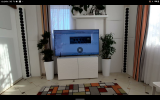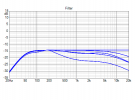At last the speakers are in their final place!
I have made some preliminary measurements but take it with a pinch of salt since the
insulation of the cabinet is not yet finished, there is a pretty severe air leakage going on (that will be fixed either today or tomorrow)
Measurements were made at main listening position using UMIK-1 with REW (1/12 smoothing) at 75dB
Frequency response:
View attachment 181197
The blue one is the original, non-compensated curve - pretty horrid, as expected
The peach is the curve that Dirac Live 3 produced when I set the target curve to be totally flat - getting there
And finally the highlighted one is a result of tweaking the target curve in Dirac + using Pultec EQ (Waves PuigTech) to further fine-tune the sound
As you can see the highs have to be compensated very heavily, eating up like 15dB of amp power
I have some pretty nasty room modes between 50-60 and 70-90Hz - I can compensate those but at the expense of increased ringing as you will see below
T60M curves for the same
View attachment 181199
I will have to decide if I prefer the more flat sound in the lows with increased ringing vs less perfect low-end with significantly lower ringing
Waterfall for the linearized Dirac + Pultec measurement:
View attachment 181200
Wavelet diagram for the same:
View attachment 181208
Step response for the same:
View attachment 181203
Impulse response for the same:
View attachment 181204
IR zoomed in:
View attachment 181205
Distortion curves - these look pretty bad but I suspect that the air leakage might have some impact here:
View attachment 181207
And finally, a video that shows how it looks and how it sounds:

photos.app.goo.gl
Here are some additional thoughts:
- dynamics are extremely good
- transients are excellent (really 'fast' sound)
- stage is wide, but
precise but obviously not too deep
- phantom center is a bit less forward vs my
previous setup
- sound is no less detailed vs my previous setup - both micro and macrodynamics are excellent
-
sub is definitely not needed for music, there is plenty of energy down to below 25Hz
- even for movies I will not consider using a sub, however I need to say that the impact is a bit less compared to my previous setup where I had two 12" subs too (however the lows seem to be more 'detailed' with the line arrays)
- footprint is extremely small (the speakers are tall but they consume virtually no space since they are in the corners) - WAF just went over the roof, at least in my case

-
very heavy EQ compensation is needed so take that into account when choosing an amp for such a project
- sound is kind of filling the whole room, anywhere you go, stand, sit, lie, etc. you hear almost the same
- my listening spot is 325cm away but even if I go to the other end of the room (720cm) volume does not seem to decrease (see above point)
The next steps will be to fix the insulation then I will post a new set of measurements in a few weeks' time once the drivers had their 'break-in'




